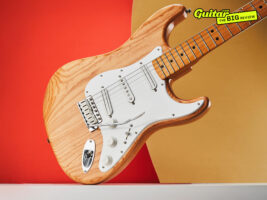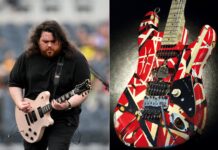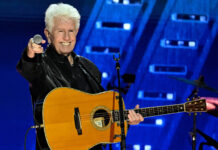
Fender Mark Speer Stratocaster review: “a 70s Strat that everyone can enjoy?”
$1,499/£1,399, fender.com
Part of the extraordinary success and enduring appeal of the Fender Stratocaster is its malleability. Perhaps more than any other golden era electric guitar design, the Strat’s basic recipe has a receptiveness to tinkering and evolution that has enabled it to be used in every genre imaginable.
READ MORE: “I’m not a guitar player – I play THAT guitar”: how Khruangbin recreated their unique voice on their first signature instruments
I’ve owned quite a few off-the-shelf Strats myself over the years, and there hasn’t been one that I haven’t tweaked in some way – whether that involves changing the pickups, swapping the bridge, or upgrading the tuners.
All this means that we’re often quite inured to leftfield Strat variants – a Strat is a Strat, right? And yet, this latest Fender signature guitar for Khruangbin guitarist Mark Speer is a very different flavour of Strat to the norm – indeed, it’s one of the most personalised Strats Fender has put out in a while.
Image: Adam Gasson
Fender Mark Speer Stratocaster – what is it?
This signature model (which arrives alongside a signature bass from bandmate Laura Lee) is heavily modelled on the Strat that Speer has used almost exclusively in his time with Khruangbin – which has been tweaked and modded extensively over that time.
The original guitar is a 2001 Fender Classic Series ’70s Stratocaster, and the spec sheet pulls in a lot of the biggest hits from that much-maligned original era of guitars. So you’ve got the vintage fretboard radius, you’ve got the big 70s headstock, a natural finish and in this case it even comes fitted with flatwound strings.
You probably have your opinions on all of that – I certainly do. As someone who prefers his Strats to have none of the above, you might even describe this as my own personal Fender nightmare, but there is one notorious design feature here that I will forgive it all for.
The Micro-Tilt neck with its three-bolt assembly is often held up as an example of everything wrong with the CBS era, but many of the changes implemented to the core design in this period actually came from Leo Fender himself, who stuck around in a consultancy role for a while before moving on to Music Man in 1979.
The Micro-Tilt is one such innovation; allowing you to tweak the angle of the guitar’s neck in relation to the instrument body via a small hex key hole in the neck plate. It enables extra control over fine-tuning the guitar’s setup as a result. This innovation also led to the introduction of the bullet truss rod and the moving of the adjustment to the top of the neck instead of the bottom. Both of these are genuinely good things for the playability and ease of maintenance of a Strat, no matter what vintage guitar aficionados tell you.
That’s all present and correct on the Speer Strat, and so it’s a big tick from me in that regard, but from there things get a bit more freaky. You’ll notice, for example, the presence of white Graph Tech saddles, which are designed to improve tuning stability by reducing friction on the break angle. These may be a visually jarring appointment but are borne of real-world experience.
Image: Adam Gasson
“A lot of those adjustments were made from a pragmatic standpoint,” Mark explains. “The Graph Tech saddles were there because I just don’t want strings to break that often. When you’re a struggling working musician, buying strings all the time is not something you like doing.” Fair point.
The graphite additions extend to not one, but two string trees, which not only provide the steeper break angle over the nut but, in the case of the G string, prevents that pesky harmonic that sometimes rings out when not required.
Other breaks from the norm include a pair of DiMarzio Pro Track single-coil-sized rail humbuckers in the bridge and neck. These were chosen mainly because Mark dislikes the hum from single coils – but you can certainly hear their strident tones in Khruangbin’s music.
The original 2001 guitar had an ash body, and so it is here – that in itself is notable because it’s quite rare to see on a production Fender guitar in 2025, with a few Player II chambered Strat and Tele variations proving welcome exceptions on the affordable front. Sadly, the devastating toll that various pests have had on the global ash tree population has made what was once a hugely prevalent wood harder to find, and so the brand began phasing out ash-bodied production guitars in 2020. Clearly, they are back on the scene, though in select model runs. And the transparent nature of the original guitar’s finish meant that ash was the only choice to replicate it properly.
Image: Adam Gasson
Fender Mark Speer Stratocaster – build and playability
I must admit, the mere sight of an ash body causes my back to spasm, such has been the weight of ash-bodied guitars I’ve owned in the past. However, clearly I’ve just been choosing my guitars unwisely, as pulling the Speer out of its suitably 70s brown-tolex hard case reveals it to be not just light – but 7lbs light. Highly unusual for a Strat in 2025.
I must admit I’ve never loved the natural finish on guitars of this era – they just look thick and sticky, and a bad reminder of when Fender switched to polyurethane finishes. Again, to give it a thin nitro sheen would be deviating from the original guitar, and Speer clearly feels that it’s served him well thus far.
The neck carve has been created in conjunction with Speer and it’s best described as a typical modern ‘C’ shape and very comfortable. The jumbo fretwork is nicely done, and the height gives me some reassurance that the vintage 7.25” radius won’t be too impactful upon playability and the ability to bend.
All in all, it feels a solid, well put together guitar – the sort of thing you’ve come to expect from Fender’s Ensenada-made signature models in recent years.
Image: Adam Gasson
Fender Mark Speer Stratocaster – sounds
Plugged into my Fender ’64 Deluxe Reverb with the reverb in full effect, emulating Speer’s tone is a cinch. The Dimarzio Protrack bridge pickup is based on a vintage PAF and unsurprisingly doesn’t provide typical single-coil chime, but it sounds quite warm whilst not unpleasantly driving the amp in the manner we expect from rail-style pickups.
My chordal work still has an underlying twang, which isn’t often prominent in bridge humbuckers, and we are thankfully bereft of the often-scathing brightness of a single coil in the bridge position.
Iconic Strat sounds are actually found in position three (middle pickup) via a Fender single coil ‘vintage voiced 70s’ pickup. I find myself spending quite a lot of time here, as it’s a lot fuller-sounding than most middle pickups, and possesses a warmth I wouldn’t normally associate with a middle pickup.
Position two (bridge and middle pickups in phase) provides plenty of quack, and impressively, the volume doesn’t dip dramatically, as can often be the case. The same can’t be said for position four, which is wired with the middle and neck pickups out of phase. The thin hollow tone has its appeal with many famous players but the volume drop is dramatic and the amp’s volume control needs increasing somewhat to compensate.
A signature guitar can’t just be about emulating the sound of its creator, however – the best ones can work in a variety of settings. With that in mind, I load up my Mesa/Boogie Mark IV and dial in a strident lead tone.
I genuinely expected the flatwound strings to sound dull and lifeless with a higher gain setting, but pleasingly this isn’t the case at all. Heavy riffs are still heavy and switching to the neck pickup gives us some wonderful creamy vintage rock tones. What emerges is a versatile and interesting guitar with plenty of sonic real estate to occupy beyond the world of Texan-fried psychedelica.
Image: Adam Gasson
Fender Mark Speer Stratocaster – should I buy one?
On paper, the Speer Strat is everything I don’t really want in a Strat – the vintage specs, the 70s looks, it’s everything that I tend to struggle with. And yet in practice this is a guitar with a huge palette of onboard sounds contained within that five-way selector. It’s a guitar that can provide a workable tone for practically any genre thrown at it.
Even as someone who spends most of his time at the shreddier end of the guitar pool, I found the playability surprisingly great too. I was expecting the vintage radius and slinky action to lead to choking out bends, but those tall frets make it a much more accommodating experience.
Speer is an unusual and pretty unique guitar player in the modern era, and this is a guitar that befits that traditional-meets-eclectic vibe that he has brought to Khruangbin. A 70s Strat that everyone can enjoy? Try one and tell me I’m wrong…
Fender Mark Speer Stratocaster – alternatives
Another S-type guitar that offers a bunch of handy pro-ready fixes and evolutions is Yamaha’s reimagined Pacifica Standard Plus ($1,349/£1,249). Another S-type guitar with rail-type humbuckers is PRS’s hugely impressive SE NF3 ($799/£799) – it’s one of the finest sub-$1,000 guitars around. Fender also offers a modded take on the Strat in its own line-up, of course, and the Player II Modified HSS Strat ($1,079.99/£999) is a very impressive example.
The post Fender Mark Speer Stratocaster review: “a 70s Strat that everyone can enjoy?” appeared first on Guitar.com | All Things Guitar.
Source: www.guitar-bass.net












